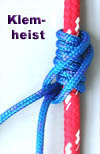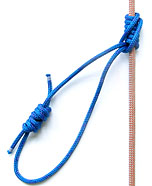Klemheist knot: Difference between revisions
m (This article was propably imported from Wikipedia, http://en.wikipedia.org/wiki/{{PAGENAME}}) |
m (Robot: Automated text replacement (-\[\[(Webbing)\]\] +\1); cosmetic changes) |
||
| Line 16: | Line 16: | ||
[[Image:Klemheist2.jpg|right|Klemheist knot with loop]] | [[Image:Klemheist2.jpg|right|Klemheist knot with loop]] | ||
The '''Klemheist knot''' (or '''Machard knot''') is a type of [[friction hitch]], used as part of a system to ascend or descend a [[rock climbing|climbing]] rope. | The '''Klemheist knot''' (or '''Machard knot''') is a type of [[friction hitch]], used as part of a system to ascend or descend a [[rock climbing|climbing]] rope. As with other friction knots, it grips the rope when weight is applied and is free to move when the weight is released. It is similar in function to the [[Prusik knot]] and the [[Bachmann knot]] which has the advantage over the prusik that a loop of webbing can be used as an alternative to cord. The Klemheist tends to be easier to slide up than a Prusik, but does not work well with webbing. | ||
== Technique == | == Technique == | ||
A Prusik loop is wrapped round the climbing rope two or three three times. | A Prusik loop is wrapped round the climbing rope two or three three times. The loop is then threaded through itself and carefully tightened to wrap the climbing rope neatly. In use strain must only be taken on the hanging loop. Never grip and pull on the knot itself - a rapid descent can occur! If the knot slips when load is placed on the hanging loop, wrap the loop around the climbing rope another time or two as necessary until there is no slippage. | ||
Instructions for tying a [[Klemheist knot]], a [[Prusik knot]] and a [[Bachmann knot]] may also be found on the Chockstone link below | Instructions for tying a [[Klemheist knot]], a [[Prusik knot]] and a [[Bachmann knot]] may also be found on the Chockstone link below | ||
| Line 26: | Line 26: | ||
*[http://www.chockstone.org/TechTips/prusik.htm Chockstone: Friction Knots] | *[http://www.chockstone.org/TechTips/prusik.htm Chockstone: Friction Knots] | ||
NB: | NB: Sometimes the knot name is misspelled 'Kleimheist'--extra "i". ("Klem" I believe means "clamp" or ... in German; | ||
the general class of knots seems to be "klemmnoten". | the general class of knots seems to be "klemmnoten". | ||
For an authoritative discussion on friction hitches, cf. Mark Adams's "Son of a Hitch" at | For an authoritative discussion on friction hitches, cf. Mark Adams's "Son of a Hitch" at | ||
www.treebuzz.com/pdf/0505_geneology.pdf | www.treebuzz.com/pdf/0505_geneology.pdf | ||
[[pl:Węzeł francuski]] | |||
[[ru:Австрийский схватывающий узел]] | |||
[[Category:Climbing knots]] | [[Category:Climbing knots]] | ||
[[it:Nodo machard]] | [[it:Nodo machard]] | ||
Revision as of 12:38, 17 January 2010
| Klemheist knot | |
|---|---|
| Names | Klemheist knot, Machard knot |
| Category | hitch |
| Related | Prusik knot, Bachmann knot |
| Typical use | Rock climbing |
| ABoK | #1762 |
The Klemheist knot (or Machard knot) is a type of friction hitch, used as part of a system to ascend or descend a climbing rope. As with other friction knots, it grips the rope when weight is applied and is free to move when the weight is released. It is similar in function to the Prusik knot and the Bachmann knot which has the advantage over the prusik that a loop of webbing can be used as an alternative to cord. The Klemheist tends to be easier to slide up than a Prusik, but does not work well with webbing.
Technique
A Prusik loop is wrapped round the climbing rope two or three three times. The loop is then threaded through itself and carefully tightened to wrap the climbing rope neatly. In use strain must only be taken on the hanging loop. Never grip and pull on the knot itself - a rapid descent can occur! If the knot slips when load is placed on the hanging loop, wrap the loop around the climbing rope another time or two as necessary until there is no slippage. Instructions for tying a Klemheist knot, a Prusik knot and a Bachmann knot may also be found on the Chockstone link below
External links
NB: Sometimes the knot name is misspelled 'Kleimheist'--extra "i". ("Klem" I believe means "clamp" or ... in German; the general class of knots seems to be "klemmnoten".
For an authoritative discussion on friction hitches, cf. Mark Adams's "Son of a Hitch" at www.treebuzz.com/pdf/0505_geneology.pdf pl:Węzeł francuski ru:Австрийский схватывающий узел

